This weekend I planned on finally visiting one of London’s blockbuster sights – St. Paul’s Cathedral. Despite living in London for over a year and visiting for a good chunk of time before that, I haven’t actually managed to set foot in the cathedral since 1988, when I recall having a lovely visit. But really, it’s the kind of place that bears visiting more than once every 23 years. Unfortunately when I surfed on over to the cathedral’s website to check on mundane matters like opening times and admission costs I discovered that it has just been closed to the public until further notice due to the continuing “Occupy London” protest that has been camped on the doorstep of St. Paul’s since last week. The decision to close the cathedral was made by the Dean of St. Paul’s and is, in the Dean’s own words, “unprecedented in modern times”. The last time it happened was during World War II, which I suppose means the Dean is being a bit free with the term “modern times” but let’s not pick nits with the poor man, he’s had a hard week.
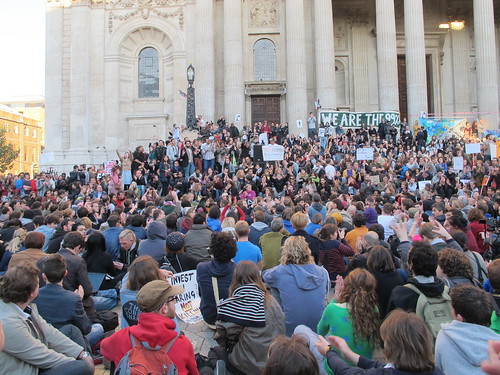 |
| I don’t care if you ARE the 99%, find somewhere else to have your little camp-out. The Bank of England is just down the street - surely that’s a more appropriate location. |
With my original plan thwarted I quickly scanned my list of Tourist Stuff to Blog About (of course there’s a list!) and hit on a new target: the
Old Operating Theatre Museum.
“Operating theatre” is the UK term for an operating room – as in the place where one performs surgery. (You would know this if you’d been faithfully studying the Go Stay Work Play Live
Glossary like good little blog readers.) Operating theatres date to the late Georgian and Victorian era when the relatively new profession of surgeon – as distinct from the older medieval craft of the barber surgeon (they of the leeches and cupping and such) – became more common. The boom in the profession resulted in the need for more schools, hence the existence of more students, hence the need for lots of students to be able to observe the procedures they were meant to be learning. This led to the emergence of purpose-built operating theatres where a large audience of students and other interested parties could watch the gruesome proceedings with good sightlines and an ample supply of hot buttered popcorn.
Thus armed with this knowledge of UK vernacular and the surgical practices of the Victorians you likely won’t be surprised to learn that the Old Operating Theatre Museum is exactly what it says on the tin: a museum dedicated to showcasing the oldest operating theatre still in existence in England. The museum is a tiny space accessed by a charming winding staircase that reminded me very much of the trip up to the ringing room at
St. Botolph’s.
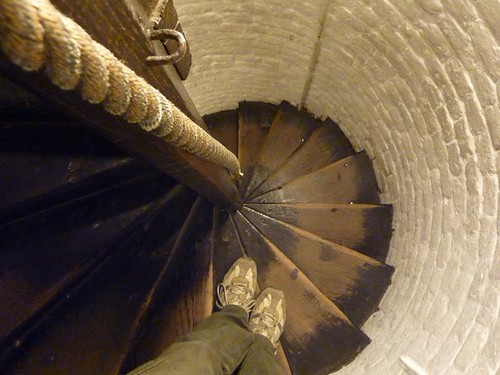 |
| Look! Pam’s feet are back! (That will only mean something to you if you read my old blog, where pictures of my feet cropped up irregularly.) (Or, I suppose, if you’ve got a thing about feet, which is something I would advise you to keep to yourself.) |
The museum and operating theatre occupy a rooftop garret in St. Thomas’ Church, which was the chapel for St. Thomas’ Hospital. The hospital started life as a hospice for the poor and sick near London Bridge some time in the 12th century, and St. Thomas’ Hospital stood on the same site until the whole works was packed up and moved west to Lambeth in 1862, where the current St. Thomas’ Hospital still operates. When that move occurred the operating theatre was boarded up and forgotten. It wasn’t rediscovered until 1956 when Raymond Russell investigated the attic of the church while researching the history of St. Thomas’. What he discovered was the shell of the old theatre and the adjoining garret, which had been used by the hospital’s apothecary for drying and storing a large array of medicinal herbs.
The Herb Garret, as it’s known, is now used as a display area showcasing oodles of cringey Georgian and Victorian era medical paraphernalia including, among many many other things, a wicked array of forceps for assisting in childbirth, assorted chunks of human anatomy preserved in their original Victorian jars of formaldehyde, a stomach pump that handily converted to an enema kit (with, one fervently hopes, separate nozzles for each function), and this lovely display of random jars and other assorted bits, which was backlit by the autumn sun in a particularly fetching way.
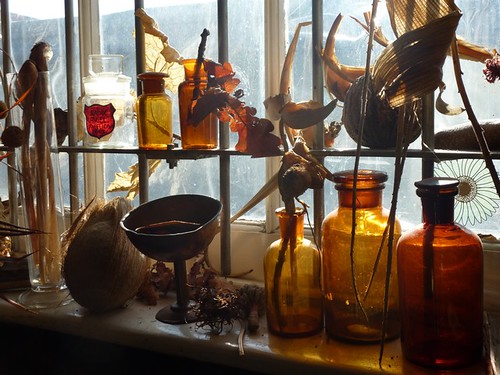 |
| Pretty! |
And then of course there was the operating theatre itself, now beautifully restored and including an original wooden operating table with lots of saw nicks along the sides, and the stands from which students would have observed the proceedings.
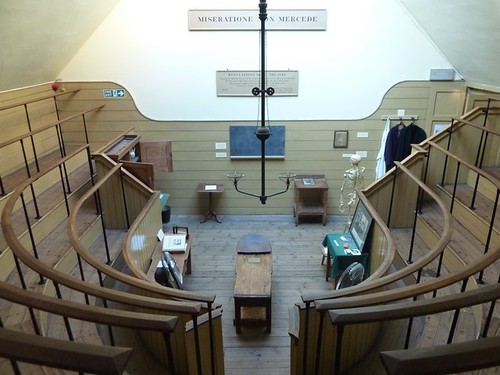 |
| The Latin motto on the back wall says “Miseratione Non Mercede”, meaning “for compassion not for gain.” |
“But wait”, I hear you saying, “Wasn’t it incredibly unsanitary to have a hundred grubby students hanging around during surgery?” Of course the answer is YES, 19th century operating theatres were
incredibly unsanitary. However this was in the time before the pioneering work of
Joseph Lister, the man who first promoted the idea that hacking someone open might result in fewer fatal infections if the patient, surgeons, instruments and general area were actually clean. Before Lister’s life-saving work (which started in about 1865) surgeries were regularly performed in whatever place was handy, and surgeons were more likely to wash their hands
after an operation than before. Surgeons were even noted for wearing the same old frock coat to surgery after surgery. Lister himself apparently “…wore an old blue frock-coat for operation, which he had previously worn in the dissecting room’, and which was ‘stiff and glazed with blood. Dirty coats were seen as a sign of a surgeon’s knowledge and experience, and the smell was referred to as ‘good old surgical stink’.”
You might wonder why anyone would possibly consent to surgery under such circumstances, especially when you consider that this was not just the pre-antiseptic era of medical practice, but also the
pre-anesthetic era as well. That’s right: NO ANESTHETIC. This means that you had to be pretty far gone to agree to have your leg hacked off in the 19th century. What made surgeries – especially amputations – common goes back to that pre-antiseptic problem. The fact is that if you suffered a relatively common injury like a bad burn or a compound fracture there was a better than average chance that infection would set in. And if your immune system wasn’t able to fend off the infection and it advanced into your bloodstream it was definitely time to start informing your next-of-kin. Thus anyone who wound up on the operating table at St. Thomas’ had very little to lose.
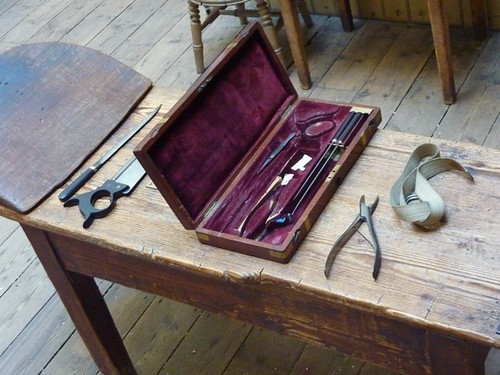 |
| The operating table and kit of surgeons’ tools including tourniquet strap, saws, knives and *shudder* BONE NIPPERS… |
The most informative part of my visit to the Old Operating Theatre Museum was the free presentation on 19th century surgery (every Saturday at 2:00pm, which worked out quite handily for me). A woman who never revealed her name gave a very interesting talk about the history of the hospital and about Victorian surgical practice in general. For instance, she told us about the team of four to six “dressers” that would be employed for every surgery. These would usually be senior students of the surgeon involved and their task was simply to hold the patient down once the cuttin’ commenced. She also told us about the remarkable speed that the best surgeons were known for. Remember that there was no anesthetic so the kindest thing a surgeon could do for the patient was to get matters over with double-quick. Some of the most renowned surgeons of the day could remove a limb in under a minute. She even demonstrated a favourite back-handed hook cut with a long knife and a somewhat disquieting glint in her eye.
Yes, the Old Operating Theatre Museum was pleasingly diverting, and a relative bargain at £5.90 for admission. It’s also easy to get to (London Bridge tube and rail and the #133 bus goes there right from Brixton, if it just happens to be a weekend when the Victoria Line is off…). The displays are interesting, but they didn’t hold my interest for more than about 45 minutes so if you’re keen on visiting I’d recommend arriving at about 1:00pm on a Saturday, thus giving you ample time to absorb the horrors of the convertible stomach pump/enema and other goodies and still get a good spot for the 2:00pm amputation. Then you’ll have much of the afternoon left to take in the area’s other highlights like
Borough Market or
Southwark Cathedral or (if you’re especially clever) the
George Inn, a particularly splendid pub dating from medieval times and now housed in a 17th century galleried coaching house. The George Inn serves proper real ale and is Go Stay Run Eat Drink’s approved pub for the London Bridge area, so please mention me when you go and maybe the next time I’m there I’ll get a free pint.
P.S. As ever, there are a few more photos of my afternoon over at
Flickr.








2 Comments:
Such a timely macabre post as we are nearing Halloween! Perhaps it should go on my list for my next visit to London!
Geez. I now have a new list of things to be thankful for!
Post a Comment